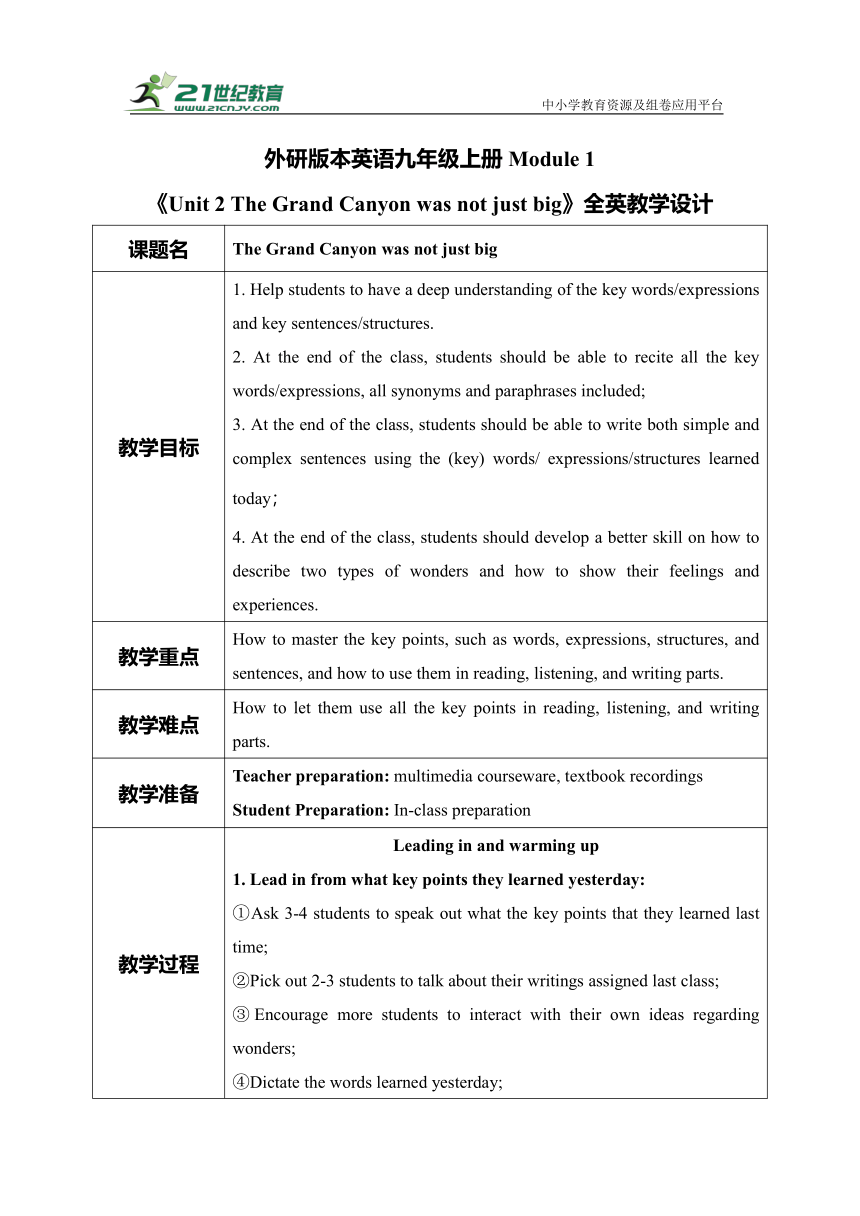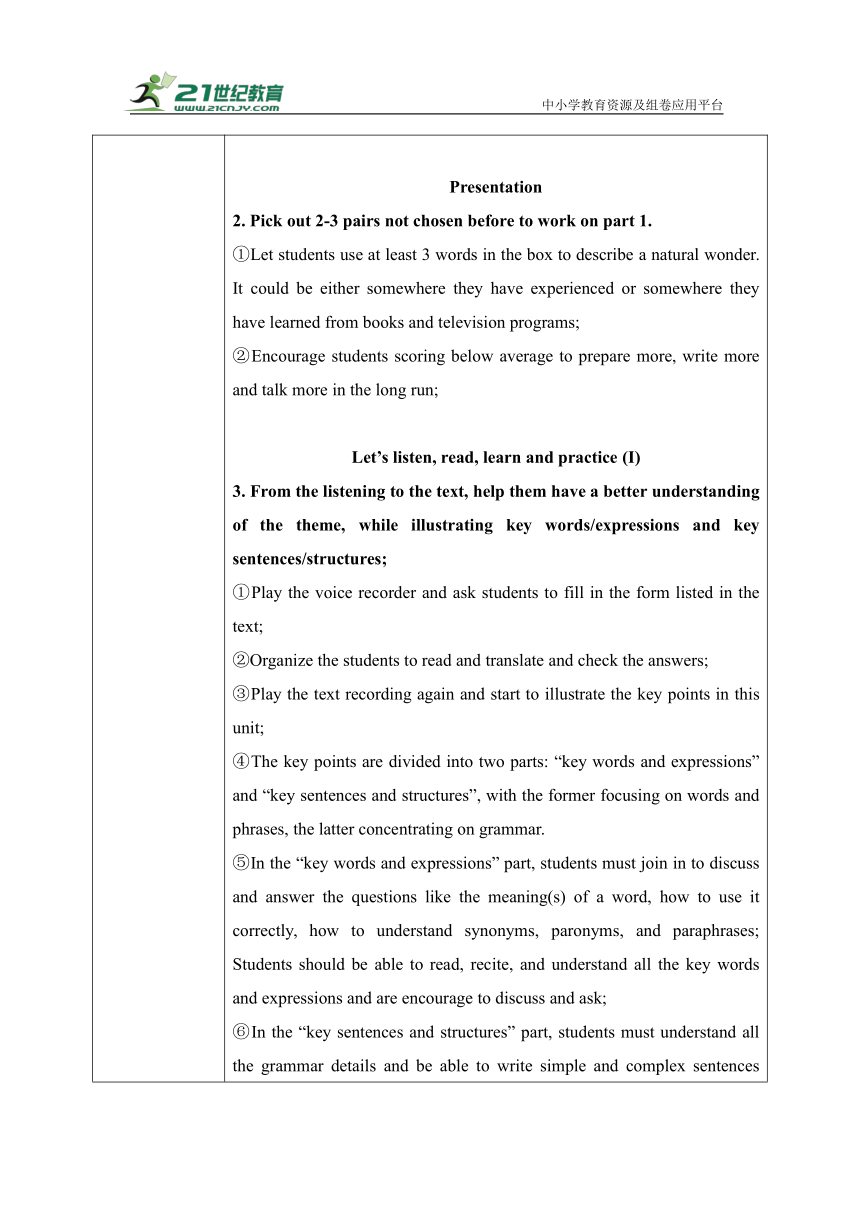Module 1 Unit 2 The Grand Canyon was not just big 教案
文档属性
| 名称 | Module 1 Unit 2 The Grand Canyon was not just big 教案 |  | |
| 格式 | docx | ||
| 文件大小 | 133.7KB | ||
| 资源类型 | 试卷 | ||
| 版本资源 | 外研版 | ||
| 科目 | 英语 | ||
| 更新时间 | 2022-07-04 10:21:03 | ||
图片预览


文档简介
中小学教育资源及组卷应用平台
外研版本英语九年级上册Module 1
《Unit 2 The Grand Canyon was not just big》全英教学设计
课题名 The Grand Canyon was not just big
教学目标 1. Help students to have a deep understanding of the key words/expressions and key sentences/structures. 2. At the end of the class, students should be able to recite all the key words/expressions, all synonyms and paraphrases included; 3. At the end of the class, students should be able to write both simple and complex sentences using the (key) words/ expressions/structures learned today; 4. At the end of the class, students should develop a better skill on how to describe two types of wonders and how to show their feelings and experiences.
教学重点 How to master the key points, such as words, expressions, structures, and sentences, and how to use them in reading, listening, and writing parts.
教学难点 How to let them use all the key points in reading, listening, and writing parts.
教学准备 Teacher preparation: multimedia courseware, textbook recordings Student Preparation: In-class preparation
教学过程 Leading in and warming up 1. Lead in from what key points they learned yesterday: ①Ask 3-4 students to speak out what the key points that they learned last time; ②Pick out 2-3 students to talk about their writings assigned last class; ③Encourage more students to interact with their own ideas regarding wonders; ④Dictate the words learned yesterday; Presentation 2. Pick out 2-3 pairs not chosen before to work on part 1. ①Let students use at least 3 words in the box to describe a natural wonder. It could be either somewhere they have experienced or somewhere they have learned from books and television programs; ②Encourage students scoring below average to prepare more, write more and talk more in the long run; Let’s listen, read, learn and practice (I) 3. From the listening to the text, help them have a better understanding of the theme, while illustrating key words/expressions and key sentences/structures; ①Play the voice recorder and ask students to fill in the form listed in the text; ②Organize the students to read and translate and check the answers; ③Play the text recording again and start to illustrate the key points in this unit; ④The key points are divided into two parts: “key words and expressions” and “key sentences and structures”, with the former focusing on words and phrases, the latter concentrating on grammar. ⑤In the “key words and expressions” part, students must join in to discuss and answer the questions like the meaning(s) of a word, how to use it correctly, how to understand synonyms, paronyms, and paraphrases; Students should be able to read, recite, and understand all the key words and expressions and are encourage to discuss and ask; ⑥In the “key sentences and structures” part, students must understand all the grammar details and be able to write simple and complex sentences with the words and grammar learned or reviewed in this unit; ⑦It’s better for the students to be able to read all those words/sentences time permitting; Let’s listen, read, learn and practice (II) 4. Do some exercise on the book and correct the answers; ①Give them 7 minutes or so to skim the text again and answer the questions in 3, and 4; Randomly pick out 6-8 students to check the answers; ②Let students compare part 4 with the text to have a better and deeper understanding of “paraphrase”. ③Encourage students to try writing a text using paraphrase like part 4; ④Ask if they have any further questions, if so, illustrate a little; if not, move to the next part. Practice from previous exam & Summary 5. Do some practice before summarizing; ①Give them 4-6 minutes to finish all the questions and randomly pick out 5 students different from previous ones to check the answers and they must explain how and why they choose or write it/them; ②Make them aware that all the questions are taken from the real High School Entrance Exams and that they should treat every single word/sentence seriously; ③Have a quick review/summary on what are learned today and invite more students to interact and complete the key points. Referring to the notes is permitted. Key points next time 6. Let the students know that what are learned next time and that what they can prepare if time permits. Homework 7. Assign homework. Pick out 1 student to read out the homework listed and translate.
课后作业 Listed in PPT.
教学反思 1. How to interact more 2. Students below average should be encouraged. 3. How to make student get used to the high-stressed class
外研版本英语九年级上册Module 1
《Unit 2 The Grand Canyon was not just big》全英教学设计
课题名 The Grand Canyon was not just big
教学目标 1. Help students to have a deep understanding of the key words/expressions and key sentences/structures. 2. At the end of the class, students should be able to recite all the key words/expressions, all synonyms and paraphrases included; 3. At the end of the class, students should be able to write both simple and complex sentences using the (key) words/ expressions/structures learned today; 4. At the end of the class, students should develop a better skill on how to describe two types of wonders and how to show their feelings and experiences.
教学重点 How to master the key points, such as words, expressions, structures, and sentences, and how to use them in reading, listening, and writing parts.
教学难点 How to let them use all the key points in reading, listening, and writing parts.
教学准备 Teacher preparation: multimedia courseware, textbook recordings Student Preparation: In-class preparation
教学过程 Leading in and warming up 1. Lead in from what key points they learned yesterday: ①Ask 3-4 students to speak out what the key points that they learned last time; ②Pick out 2-3 students to talk about their writings assigned last class; ③Encourage more students to interact with their own ideas regarding wonders; ④Dictate the words learned yesterday; Presentation 2. Pick out 2-3 pairs not chosen before to work on part 1. ①Let students use at least 3 words in the box to describe a natural wonder. It could be either somewhere they have experienced or somewhere they have learned from books and television programs; ②Encourage students scoring below average to prepare more, write more and talk more in the long run; Let’s listen, read, learn and practice (I) 3. From the listening to the text, help them have a better understanding of the theme, while illustrating key words/expressions and key sentences/structures; ①Play the voice recorder and ask students to fill in the form listed in the text; ②Organize the students to read and translate and check the answers; ③Play the text recording again and start to illustrate the key points in this unit; ④The key points are divided into two parts: “key words and expressions” and “key sentences and structures”, with the former focusing on words and phrases, the latter concentrating on grammar. ⑤In the “key words and expressions” part, students must join in to discuss and answer the questions like the meaning(s) of a word, how to use it correctly, how to understand synonyms, paronyms, and paraphrases; Students should be able to read, recite, and understand all the key words and expressions and are encourage to discuss and ask; ⑥In the “key sentences and structures” part, students must understand all the grammar details and be able to write simple and complex sentences with the words and grammar learned or reviewed in this unit; ⑦It’s better for the students to be able to read all those words/sentences time permitting; Let’s listen, read, learn and practice (II) 4. Do some exercise on the book and correct the answers; ①Give them 7 minutes or so to skim the text again and answer the questions in 3, and 4; Randomly pick out 6-8 students to check the answers; ②Let students compare part 4 with the text to have a better and deeper understanding of “paraphrase”. ③Encourage students to try writing a text using paraphrase like part 4; ④Ask if they have any further questions, if so, illustrate a little; if not, move to the next part. Practice from previous exam & Summary 5. Do some practice before summarizing; ①Give them 4-6 minutes to finish all the questions and randomly pick out 5 students different from previous ones to check the answers and they must explain how and why they choose or write it/them; ②Make them aware that all the questions are taken from the real High School Entrance Exams and that they should treat every single word/sentence seriously; ③Have a quick review/summary on what are learned today and invite more students to interact and complete the key points. Referring to the notes is permitted. Key points next time 6. Let the students know that what are learned next time and that what they can prepare if time permits. Homework 7. Assign homework. Pick out 1 student to read out the homework listed and translate.
课后作业 Listed in PPT.
教学反思 1. How to interact more 2. Students below average should be encouraged. 3. How to make student get used to the high-stressed class
同课章节目录
- Module 1 Wonders of the world
- Unit 1 It's more than 2,000 years old.
- Unit 2 The Grand Canyon was not just big.
- Unit 3 Language in use
- Module 2 Public holidays
- Unit 1 My family always go somewhere interesting a
- Unit 2 We have celebrated the festival since the f
- Unit 3 Language in use
- Module 3 Heroes
- Unit 1 She trained hard,so she became a great play
- Unit 2There were few doctors, so he had to work ve
- Unit 3 Language in use
- Module 4 Home alone
- Unit 1 I can look after myself, although it won’t
- Unit 2 I became so bored with their orders that I
- Unit 3 Language in use
- Module 5 Museums
- Unit 1 Don't cross that rope!
- Unit 2 If you ever go to London, make sure you vis
- Unit 3 Language in use
- Module 6 Problems
- Unit 1 If I start after dinner, I'll finish it be
- Unit 2 If you tell him the truth now, you will sho
- Unit 3 Language in use
- Revision Module A
- Module 7 Great books
- Unit 1 We're still influenced by Confucius's idea
- Unit 2 It is still read and loved.
- Unit 3 Language in use
- Module 8 Sports life
- Unit 1 Daming wasn't chosen for the team last time
- Unit 2 He was invited to competitions around the w
- Unit 3 Language in use
- Module 9 Great inventions
- Unit 1 Will computers be used more than books in t
- Unit 2 Will books be replaced by the Internet?
- Unit 3 Language in use
- Module 10 Australia
- Unit 1 I have some photos that I took in Australia
- Unit 2 The game that they like most is Australian
- Unit 3 Language in use
- Module 11 Photos
- Unit 1 He's the boy who won the photo competition
- Unit 2 The photo which we liked best was taken by
- Unit 3 Language in use
- Module 12 Save our world
- Unit 1 If everyone starts to do something, the wor
- Unit 2 Repeat these three words daily: reduce, reu
- Unit 3 Language in use
- Revision Module B
